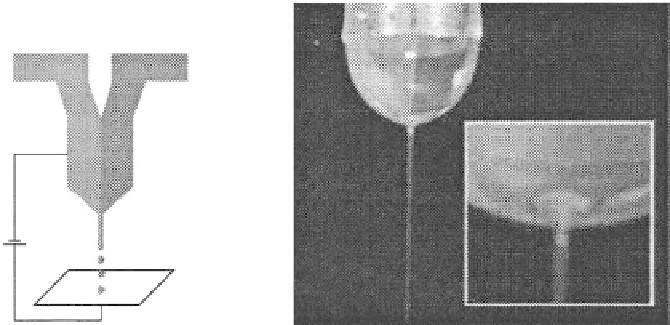Biomedical Engineering Reference
In-Depth Information
of drugs and the polymorphic changes taking place during the electrospraying of melts, as well as
the moisture entrapment during the solidifi cation process.
11.2.8.1.2 Targeted Drug Delivery
Targeted drug delivery directs a therapeutic agent in a site-specifi c manner, which embodies the
delivery of the therapeutic agent to a specifi c organ or location in the body [57-59]. The targeted
drug delivery utilizes a specifi c carrier-site interaction to seek its cellular target. The micro- and
nanometer delivery particles prepared using electrospraying can be allowed to pass through small
intercellular openings to target the tissues or organs easily. Furthermore, the antibodies can be cou-
pled onto the electrosprayed particles to achieve more effi cient targeting. The recent development
of nanotechnology has resulted in a variety of new processes to prepare targeted drug delivery,
focusing on formulating therapeutic agents in biocompatible nanocomposites, which in general can
be applied to provide targeted delivery of drugs, proteins, peptides, and genes in a specifi c tissue or
in organs. Electrospraying can be considered as a promising technique to prepare targeted delivery
carriers due to the controllable size and effi cient encapsulation of biomedical agents.
Polymer-based particles with two distinct phases were recently prepared by electrospraying two
polymer solutions by Roh et al. [60]. The individual phase was independently loaded with biomole-
cules or selectively modifi ed with model ligands. During the processing experiment, a laminar fl ow
of two distinct polymer solutions was pumped at suitable fl ow rates through a modifi ed nozzle with
side-by-side geometry, as shown in Figure 11.16a. A micrograph of the outlet region of the nozzle is
shown in Figure 11.16b, revealing the biphasic character of the jetting liquid. Each jetting solution
was prepared by dissolving the components in distilled water. In this experiment, dilute aqueous
solutions of polyethylene oxide (PEO) and polyacrylic acid (PAA) were prepared with added dye
or molecules in a certain concentration to reveal the biphasic structure. The transmission electron
microscopy (TEM) images showed that most of the PEO-based particles had diameters between
100 and 400 nm, and the PAA-based particle had an average diameter of 170 nm. Particles made
of PEO were spindle-like and had a relatively narrow size distribution, whereas PAA particles had
almost perfect spherical morphology and were discontinuous.
Electrospraying was also applied to prepare particles with surface-selective chemical modifi -
cation. These particles will be developed to targeted delivery carriers. Figure 11.17a shows single-
phasic nanocolloids prepared by electrospraying solutions composed of PEO and amino-dextran.
The free amine groups of the particles were subsequently modifi ed with 4,4-difl uoro-5,7-dime-
thyl-4-bora-3a,4a-diaza-s-indacene-3-propionic acid, succinimidyl ester (BODIPY) ligands. After
chemical modifi cation, the amino-modifi ed nanocolloids showed homogenously distributed green
Liquid A
flow
Liquid B
flow
(b)
(a)
High-
voltage
supply
1 mm
Substrate
FIGURE 11.16
Biphasic electrifi ed jetting using side-by-side dual capillaries. (Reprinted from Roh, K.H.,
Martin, D.C., and Lahann, J.,
Nat. Mater.
, 4, 759, 2005. © Nature Publishing Group. With permission.)



